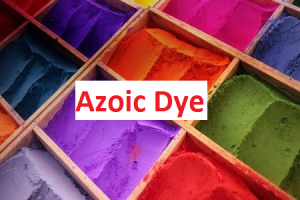
Cotton is the most popularly used fiber around the world largely due to its comfort and feel to the individual’s body. It is treated in its natural form or made anew through forms like modal, viscose or blended with synthetics. The dyes used for coloration of cotton fibre mainly constitute the reactive dyes and vat dyes though a small but vital share is held by Napthols /azoic bases. These are helpful in achieving vibrant and deep hues besides offering a large number of benefits like bleach/wash/light fastness, cost efficiencies etc.
Uniqueness of Azoic Dyeing
The dyeing process which involves the use of Napthols and bases is unique in the sense the insoluble molecule of the dye is formed within the fiber through the application of a Napthol which is then combined with a diazotized salt or base at a low temperature. Vibrant hues of yellow, orange, scarlet and red can be reproduced only by the use of these Azoic combinations.
Napthols are termed as ‘Azoic coupling components’ in this context. Fast color bases are termed as ‘Azoic Diazo components’ and these need diazotization. The success of the diazotization depends on how well you have weighed all the chemicals and adhered to the instructions of the supplier.
Overview of the Dyeing Process
The first step involves the napthol component’s dissolution. The napthol solution is then exhausted onto the cellulosic fiber or it is allowed to be absorbed by the cellulose. The surplus napthol is removed from the substrate by partial hydroextraction or squeezing. The base component’s diazotization follows next. Coupling is then brought about through treatment or development with diazonium ion solution. Neutralization to get rid of the superficial pigment is done and subsequently rinsing and drying follows.
Usage of Fast Color Bases & Fast Color Salts
It is economical to dye with napthol fast bases in comparison to reactive dyes. Wax print or African print is possible only by use of fast color bases and not otherwise. The diazotization required by fast color bases involves dispersion with sodium nitrite, below room temperature.
Fast color salts are also combined with Napthols for dyeing and printing in the textile industry. Being water soluble, fast color salts are stabilized with metal. The need for hydro-chloride acid, sodium nitrate usage is eliminated and these can be readily combined with Napthols for usage. They offer ease and convenience in handling as against fast color bases.
Sourcing from Reputed Dealers
The textile industry in India has made its mark on the global scene largely by rising up to the market challenges, product and machine ranges. Textile coloration is a vital aspect of the industry adding tremendous value to the production. A lion’s share of this value is contributed by the dyestuff industry and within this industry, manufacturers who are pioneers and dealers who stock only top quality products count a great deal. It is the reputed manufacturers and dealers who hold all kinds of dyestuff, textile auxiliaries, specialty pigments of the best class and variety. Sourcing your requirements from them is therefore, of paramount importance!